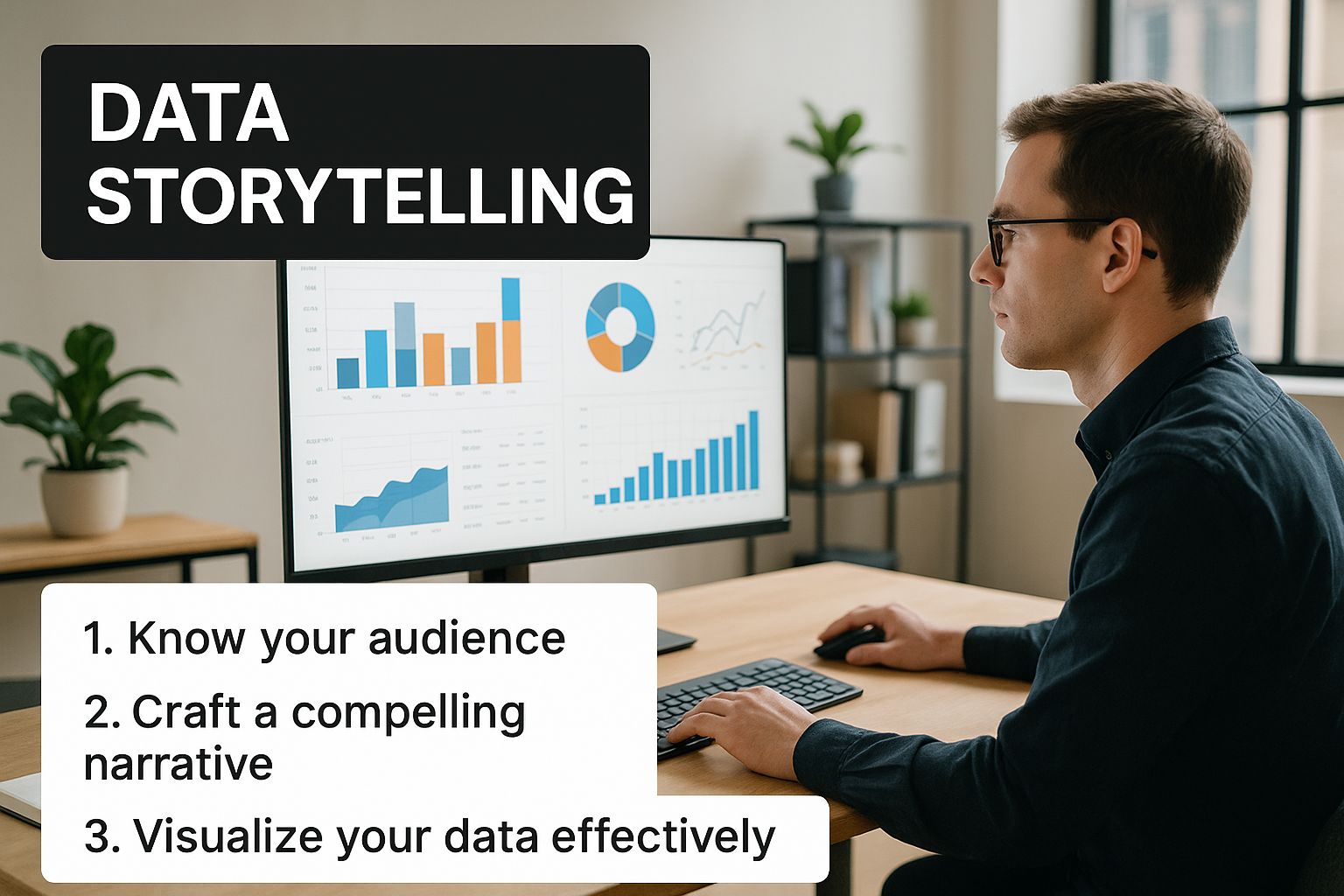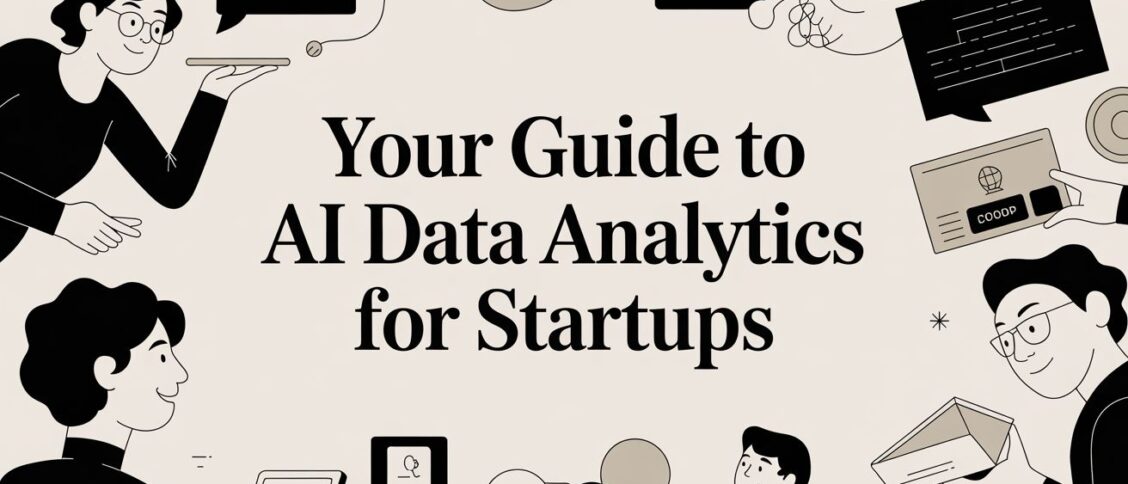Let’s cut through the jargon. Think of AI data analytics as the sharpest mind on your startup’s team. It’s the one who can sift through mountains of customer interactions and, in a flash, pinpoint a hidden trend or guess what customers will do next. It takes your analysis from just spitting out numbers to actually telling you the story behind them.
What Is AI Data Analytics, Really?
Traditional data analysis is a bit like looking in your car’s rearview mirror. It’s great at telling you where you’ve been by showing you historical performance in descriptive reports. That’s useful, for sure, but it’s all about the past.
AI data analytics, on the other hand, is your car’s satnav, complete with live traffic updates. It doesn’t just show you where you are; it predicts the quickest route to your destination and warns you about traffic jams long before you hit them.
That shift from being reactive to proactive is what gives modern businesses a real advantage. Instead of just asking, “What happened last quarter?” founders can now ask, “What’s likely to happen next quarter, and what can we do to be ready?” It’s the difference between looking at a sales report and being able to predict customer churn with 85% accuracy just by spotting tiny changes in their behaviour.
Beyond Reporting to Storytelling
At its heart, AI-powered analysis is all about finding the ‘why’ behind the ‘what’. It has a knack for connecting dots that seem totally unrelated, weaving them together into a story.
For instance, it might discover that customers who use a particular feature twice in their first week are ten times more likely to stick around after a year. That’s not just a cool statistic; it’s a powerful insight that could completely change how you onboard new users.
Getting your head around this is the first big step for any founder. If you want to dig a bit deeper, exploring a full breakdown of What Is Data Analytics With Ai is a great way to build a solid foundation. It gives you the context needed to understand how all the pieces fit together.
The image below really captures this move towards data storytelling, where raw numbers get turned into something you can build a business strategy around.

Focusing on the story helps leaders make smarter, quicker decisions that can leave competitors in the dust.
The Practical Advantage for Startups
For a startup, this isn’t some fancy nice-to-have. It’s a crucial tool for survival and growth. You can use it to personalise your marketing, tweak your pricing on the fly, or even get a heads-up about potential supply chain problems. AI doesn’t just give you a dashboard; it gives you a strategic co-pilot.
Think of it this way: Your data holds the answers to your toughest business questions. AI data analytics is the key that unlocks them, turning raw information into your most valuable asset.
Basically, it helps you to:
- Spot hidden opportunities that you’d almost certainly miss with manual analysis.
- Automate tricky decisions to make your operations run smoother.
- Craft super-personalised customer experiences that build real loyalty.
Ultimately, bringing AI data analytics into your startup means you stop guessing. You start building a business that actually learns, adapts, and gets ahead of what’s coming next.
How AI Analytics Differs From Traditional Methods
To really get what AI data analytics brings to the party, it helps to compare it to the methods you’re probably already using. Think of traditional business intelligence (BI) as a historian. It’s fantastic at meticulously recording and organising what’s already happened, giving you detailed reports on past performance. It’s incredibly valuable for that, but its eyes are firmly fixed on the rearview mirror.
AI analytics, on the other hand, is more of a futurist. It doesn’t just look at the past to report on it; it pores over that history to find hidden patterns that can predict what’s likely to come next. It’s the difference between a report saying, “Last month’s sales were down 10%,” and an alert popping up that says, “Based on current customer behaviour, sales are projected to dip next month unless you fix this friction point in your checkout process.”
This fundamental shift moves a business from a reactive posture to a proactive one. Instead of just reacting to what the numbers tell you happened yesterday, you start anticipating and shaping what happens tomorrow. It’s a total change in mindset, all powered by the core tech that makes AI tick.
The Engine Room: Machine Learning and Prediction
Right at the heart of AI analytics, you’ll find machine learning (ML). This is a process that lets computer systems learn from data without someone having to write explicit code for every single rule.
Imagine hiring a super-smart apprentice to analyse customer feedback. At first, you have to show them exactly what to look for. But over time, they start to recognise patterns all by themselves. Eventually, they get so good they can spot a potential problem brewing before it turns into a five-alarm fire. That’s what machine learning models do; they’re the apprentices that get smarter and more accurate with every new piece of data they chew on.
This ability to learn is what unlocks predictive analytics, the real game-changer for startups. Instead of just describing what has already happened, predictive models forecast what’s about to happen. For example, a traditional sales dashboard will show you which customers have already cancelled their subscriptions. A predictive model, however, can flag the customers who are at risk of cancelling, giving you a crucial window to step in and save the relationship.
A study found that predictive analytics can help businesses increase their profitability by 21% over five years. It’s not just about seeing the future; it’s about getting the chance to change it for the better.
The difference between these two approaches is night and day. One gives you hindsight, while the other offers foresight. For a startup where every decision has to count, that distinction is everything.
A Head-to-Head Comparison
To spell it out even more clearly, let’s put the old way of doing things side-by-side with the new, AI-powered approach. The table below really shows how things have evolved from just reviewing data to actively shaping your business’s future.
| Aspect | Traditional Data Analytics | AI Data Analytics |
|---|---|---|
| Primary Goal | Descriptive: Focuses on summarising historical data to understand what happened in the past. | Predictive & Prescriptive: Aims to forecast future outcomes and suggest actions to achieve desired results. |
| Data Processing | Manual & Structured: Relies heavily on human analysts to clean, process, and query structured data from databases. | Automated & Diverse: Can automatically process vast amounts of structured and unstructured data, like text and images. |
| Methodology | Static & Rule-Based: Analysts create predefined queries and reports based on known business rules and metrics. | Dynamic & Adaptive: Uses machine learning models that continuously learn and adapt as new data becomes available. |
| Key Question | “What happened, and why?” | “What is likely to happen next, and what should we do about it?” |
| Business Impact | Reactive: Provides insights that help explain past performance, guiding retrospective strategy. | Proactive: Delivers forward-looking insights that enable pre-emptive actions and shape future strategy. |
As you can see, it’s a huge leap from being a data historian to becoming a data-driven fortune teller. While traditional methods are still essential for understanding your business’s journey so far, AI data analytics gives you the map and compass for the road ahead. It helps you dodge potholes and grab opportunities before they’ve even fully appeared on the horizon.
The Rise of AI in Irish Business
Artificial intelligence isn’t some far-off concept for Silicon Valley giants anymore. It’s right here, on our doorstep, and it’s changing how business gets done across Ireland. From the tech hubs in Dublin to innovative companies popping up in Cork and Galway, Irish businesses are embracing AI data analytics to get ahead.
And this isn’t just a game for the big players. While major corporations are definitely setting the pace, small and medium-sized enterprises (SMEs) are jumping in too, realising that AI can seriously level the playing field. The adoption rates tell a very clear story about where Irish business is heading.
By 2025, around 60% of major Irish companies were already using AI solutions in some form. SMEs in the Republic of Ireland are showing a growing appetite as well, with 35% actively looking into how they can use AI. Over in Northern Ireland, about 30% of SMEs were either using or exploring AI technologies.
So, Why is AI Taking Off in Ireland?
What’s behind this shift? Well, a few things are lining up perfectly. Ireland’s status as a European tech centre means we have a fantastic ecosystem of talent and fresh ideas. On top of that, things like cloud computing and easier-to-use AI platforms have brought the cost and complexity way down, putting powerful tools within reach of businesses without massive budgets.
For most Irish businesses, it boils down to two simple things: survival and growth. They’re using AI to hit very practical, real-world targets:
- Making Customers Happier: Figuring out what customers really want by analysing their behaviour, which leads to better recommendations and support.
- Running a Tighter Ship: Using predictive analytics to manage stock, cut down on waste, and just generally make operations smoother.
- Smarter Sales and Marketing: Pinpointing the best leads and automating marketing campaigns so they reach the right people at the right time.
The real story of AI in Ireland isn’t about mind-bending algorithms. It’s about business owners finding smarter ways to solve everyday headaches and uncover new opportunities.
Knowing how your local competitors are using this tech gives you a solid benchmark. It shows you what’s actually possible and helps you spot where you can carve out your own advantage in the Irish market.

Real-World Examples from Around Ireland
Let’s get away from the numbers and look at what this actually looks like.
Picture a small Dublin e-commerce startup using AI data analytics to predict which products will be a hit next season, letting them stock up smartly and avoid having cash tied up in slow-moving items. Or think about a food producer in Munster using machine learning to spot tiny imperfections on their production line that a person might easily miss.
These aren’t daydreams; this stuff is happening right now. A FinTech company could be using AI to flag dodgy transactions with incredible speed and accuracy, protecting itself and its customers. A regional delivery firm might use AI to plan the most efficient routes, slashing fuel costs and delivery times to compete with the bigger guys.
What these examples show is that AI isn’t a magic bullet. It’s more like a flexible toolkit you can adapt to solve your specific problems, no matter what industry you’re in. For a founder, seeing these real-world applications is like getting a roadmap. You can either follow the paths others have taken or use the same tools to blaze a completely new trail for your business.
Assembling Your Startup’s AI Tech Stack
Right, let’s get practical. Building the engine for your AI data analytics doesn’t mean you need a bottomless budget or a data centre in your spare room. Think of it like setting up a workshop. You need a place to store your raw materials (data storage), a workbench to put everything together (data processing), and a set of power tools to build the finished product (AI models).
For a startup, the trick is to pick tools that are accessible, can grow with you, and won’t break the bank. You can absolutely start small and add more firepower as your business grows and your needs get clearer.
Choosing Your Core Components
Your first job is to map out the fundamental layers of your tech stack. Each layer does something specific, but they all need to work together to turn messy, raw data into something that actually helps your business.
Here’s a simple breakdown of the essentials:
- Data Storage and Warehousing: This is where all your data lives, from customer sign-ups to website clicks. Cloud-based solutions are a startup’s best friend here. Things like Amazon S3, Google Cloud Storage, or Snowflake are brilliant starting points because they’re flexible and you only pay for what you use.
- Data Processing and Transformation: Raw data is almost always messy. You’ll need tools to clean it up, get it organised, and make it ready for analysis. Services like AWS Glue or platforms such as Databricks are designed for this, helping you turn jumbled information into a clean, usable format.
- AI and Machine Learning Platforms: Now for the fun part. These are the “power tools” that build your predictive models. You don’t need a PhD in computer science to get started, either. User-friendly platforms like Google’s Vertex AI or Amazon SageMaker offer managed environments to build, train, and deploy models.
The goal isn’t to build the most complex tech stack on day one. It’s to build the right tech stack for the business questions you need to answer right now. Start lean and add complexity only when you need it.
Nailing the right combination of these tools is your first big decision.
Build vs Buy: The Startup’s Dilemma
One of the biggest choices you’ll face is whether to use ready-made platforms (buy) or build a custom solution from scratch (build). There’s no single right answer; it really depends on your team’s skills, your timeline, and what you’re trying to achieve.
Going with a “buy” approach means using an all-in-one platform that handles everything from data storage to model building. It’s much faster to get started, often more user-friendly, and perfect if your team doesn’t have deep technical expertise. The catch? You might pay more in the long run and could be hemmed in by the platform’s limitations.
On the flip side, a “build” approach involves piecing together your own stack using open-source tools like Python libraries (think pandas, Scikit-learn) and custom code. This gives you total flexibility and control, but it absolutely requires a skilled team and takes a lot more time.
For most startups, a hybrid approach is the sweet spot. You can use managed services for the heavy lifting, like data storage and processing, while your team focuses on building the custom AI models that give you a unique edge. This strategy is also becoming more popular as computing power moves closer to where data is actually created. You can explore the rise of Edge AI computing at the source to see how this trend is shaking things up.
The key is to be brutally honest about your resources. Don’t try to build a custom solution if you don’t have the in-house talent to back it up. Starting with a ready-made platform is a smart way to get results quickly and prove the value of AI data analytics before you invest more heavily.
Finding and Keeping AI Talent in Ireland
Let’s be honest, the most sophisticated AI data analytics platform in the world is just a fancy paperweight without the right people behind the wheel. That brings us to the human side of the equation: building a killer team in Ireland’s red-hot talent market.

If you want to do AI properly, you need people with a very particular set of skills. The trouble is, every company from Dublin to Cork is after them. This makes finding and keeping these experts one of the biggest strategic hurdles for any startup in this game.
First things first, you need to get a lay of the land. Understand who you’re looking for and accept that you’ll be going head-to-head with big, cash-rich corporations for their attention. While you need to budget for competitive salaries, money often isn’t the deal-breaker for the truly great candidates.
The Key Roles You’ll Need to Fill
As you start to grow, your AI team will need a blend of specialists to handle everything from scooping up data to getting your models out into the wild. One person might juggle a few of these roles at the start, but these are the core players you’ll want on your team sheet.
- Data Scientist: This is your strategist. They figure out what questions to ask, dive into the data to unearth answers, and build the machine learning models that predict what’s next.
- Data Engineer: Think of them as the architect. They build and look after the data pipelines and infrastructure, making sure the data is clean, trustworthy, and ready for analysis.
- Machine Learning (ML) Engineer: This specialist is the one who takes the models built by data scientists and makes them production-ready, focusing on making them run smoothly and at scale.
- Business Intelligence (BI) Analyst: Your team’s storyteller. They turn complex data insights into easy-to-understand charts and reports that the rest of the business can actually use to make decisions.
Despite the pressure-cooker environment, job satisfaction in these roles is surprisingly high. A recent survey of 200 data and AI professionals in Ireland found that while companies are tearing their hair out trying to hire, the experts themselves are generally happy in their jobs. You can discover more about the trends impacting data and AI roles to get the full picture. That satisfaction usually comes from getting to grips with challenging, meaningful work.
How to Actually Compete for Top AI Talent
So, how can your startup possibly stand out when you can’t throw multinational-level salaries around? You compete on a different pitch. You offer things that the big, slow-moving corporates simply can’t. Your speed and sense of purpose are your secret weapons.
Your competitive advantage isn’t just a bigger pay cheque. It’s the opportunity for someone to make a genuine impact, solve meaningful problems, and grow with a company they help build from the ground up.
Your goal is to create a place where the best minds want to be. Top talent isn’t just chasing a salary; they’re drawn to big challenges, a sense of ownership, and a mission they can get behind. For a deeper dive, check out these 3 strategies for attracting top talent to your business.
Here are a few practical ways to make your startup the place to be:
- Offer Juicy Challenges: Don’t just post a job description. Pitch them the tough, interesting problems your startup is trying to crack. Give them the freedom to experiment and come up with brilliant solutions.
- Cultivate a Great Culture: Build a workplace that’s open, collaborative, and respectful, where people feel genuinely valued. A positive culture is a magnet for talent and a powerful reason to stay.
- Provide Meaningful Equity: Give your core team a real slice of the pie. Equity gives them skin in the game, aligning everyone’s goals and rewarding long-term commitment in a way that a monthly salary never can.
Using AI Responsibly with Data and Privacy
Using AI to analyse data is powerful, no doubt. But with that power comes a serious responsibility to handle that data ethically. As a founder, trust is your most valuable currency, and how you manage data privacy will either build it or tear it down—especially with GDPR setting the standard here in Ireland and across the EU.
This isn’t just about ticking boxes on a compliance form. It’s about building a business that your customers genuinely feel safe with. It means being acutely aware of what could go wrong and proactively designing your systems to stop it from happening.
Navigating Algorithmic Bias
One of the biggest ethical tripwires you’ll encounter is algorithmic bias. Your AI model is only as good as the data it learns from. If the data you feed it is skewed or reflects historical prejudices, your AI will not only learn but also amplify those biases, leading to some seriously unfair outcomes.
Think about an AI designed to screen CVs for a developer role. If it’s trained on a decade’s worth of hiring data from a company that mostly hired men, the model will learn to favour male candidates. It’s not being intentionally malicious; it’s just mirroring the bias baked into the data it was given.
The core principle is painfully simple: biased data in, biased decisions out. It’s on you to make sure the data you feed your models is as fair and representative as it can possibly be. Otherwise, you’re just building an echo chamber of past mistakes.
This means you have to get your hands dirty and actively audit your datasets for hidden biases before you even think about training a model.
A Checklist for Ethical AI
Building ethical AI isn’t something you can bolt on at the end; it has to be part of the blueprint from day one. For a deeper dive, I’d recommend looking into developing ethical frameworks for AI implementation to help shape your strategy.
Here’s a practical checklist to get you started on the right foot:
- Practise Data Minimisation: Only collect what you absolutely need for a specific, stated purpose. Resist the urge to hoard data just in case it might be useful later.
- Prioritise Transparency: Be upfront with your customers. Tell them what data you’re collecting and how your AI is using it. Plain English beats confusing legal jargon every single time.
- Ensure Model Fairness: Regularly test your AI models to check they’re performing fairly across different demographic groups. If you spot bias, you have to go back and fix it.
- Establish Clear Accountability: Figure out who in your company is responsible for the ethical oversight of your AI. When something goes wrong, you need a clear line of accountability.
Proper data handling also means knowing when to let it go. For some great pointers on implementing effective data retention policies, it’s worth checking out some real-world examples. At the end of the day, building trust with your users is a continuous effort, not a one-off task. You have to show them, through your actions, that you respect their data and are committed to using it responsibly.
Your AI Data Analytics Questions, Answered
Alright, so you’re a founder, and you’re hearing all this buzz about AI data analytics. It’s normal to have a ton of questions swirling around. Let’s get straight to the point and tackle the big ones I hear all the time. No fluff, just practical answers to help you figure this all out.
What’s This Actually Going to Cost Me?
This is always the first question, isn’t it? The honest-to-goodness answer is… it depends. Massively. You could be looking at a few hundred pounds a month for a slick, cloud-based tool, or you could be staring down the barrel of a six-figure investment for a dedicated data science team.
The key for any startup is to start lean. Seriously, don’t get suckered into buying some flashy, enterprise-level platform that promises the world. Kick things off with scalable tools that are often free to get started, like Google Analytics 4 or Mixpanel. If you’ve got some technical chops on the team, open-source libraries are your best friend. Only open your wallet wider when you can point to a clear return on that spend.
The golden rule: Start with a specific business problem, not a piece of technology. Figure out what you need to know first, then find the most cost-effective tool to get you the answer.
This way, you keep your burn rate low while you test the waters and prove that AI can actually make a difference to your bottom line.
Do I Need to Hire a Data Scientist Right Now?
Probably not. At least, not on day one. In the early stages, you don’t need a PhD in machine learning; you need a ‘data-curious’ person on the founding team. This is someone who enjoys digging into numbers, isn’t afraid to get their hands dirty with a new analytics platform, and is always asking “why?”.
You can also get the expertise you need without the full-time salary. Think about bringing in a freelance consultant or a fractional expert for a specific, well-defined project. It’s a great way to get high-level thinking without the long-term commitment.
So, when is it time to hire a dedicated data scientist? You’ll know it when you’re swimming in a steady stream of data and you start hitting problems that your off-the-shelf tools just can’t crack. A full-timer makes sense when you need custom models built to uncover that next big competitive edge hidden in your data.
What’s the Biggest Mistake Founders Make With This Stuff?
Oh, this one’s easy. The most common pitfall by a country mile is collecting mountains of data with absolutely no plan. It’s the classic “more data must be better” trap, and it almost always leads to analysis paralysis. You’ll find yourself drowning in information but completely starved of actual insight.
It’s a huge waste of time, money, and focus. You just end up with a giant, messy digital warehouse full of data you don’t know what to do with.
Instead, flip the script. Start with a critical business question and work backwards. For instance:
- Which marketing channels are actually bringing us our most profitable customers?
- What are the top three things a user does in their first week that means they’ll stick around for a year?
- Where exactly in our onboarding flow are we losing people?
Pick a question that genuinely matters to the health of your business. Then, and only then, go find the data and the tools to answer it. This focus is what separates the startups that make real progress from those just collecting digital dust. It ensures every bit of effort you put into AI data analytics is tied directly to a meaningful business outcome.






